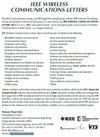PM Prediction Based on Time-Frequency Separation Feature Extraction
IF 4.6
3区 计算机科学
Q1 COMPUTER SCIENCE, INFORMATION SYSTEMS
引用次数: 0
Abstract
One of the challenges in wireless communications is the pilot and feedback overhead. In this letter, we design a deep learning based time-frequency separation feature extraction network (TFNET) to predict the precoding matrix (PM) for massive multi-input multi-output (MIMO) systems. Specifically, we first design a feature extraction network to separately extract temporal and frequency features, which yields better prediction accuracy compared to standard neural network modules. Secondly, we utilize only a subset of past time slots and frequency bands to predict the current PM, which reduces the complexity of neural networks. Simulation results demonstrate that the proposed prediction method requires 75% pilot cost and achieves 113.72% prediction accuracy compared to the baseline.基于时频分离特征提取的 PM 预测
无线通信的挑战之一是导航和反馈开销。在这篇文章中,我们设计了一个基于深度学习的时频分离特征提取网络(TFNET)来预测大规模多输入多输出(MIMO)系统的预编码矩阵(PM)。具体而言,我们首先设计了一个特征提取网络,分别提取时间和频率特征,与标准神经网络模块相比,该网络具有更好的预测精度。其次,我们只利用过去时隙和频带的一个子集来预测当前的PM,这降低了神经网络的复杂性。仿真结果表明,该方法的预测成本为75%,预测精度为113.72%。
本文章由计算机程序翻译,如有差异,请以英文原文为准。
求助全文
约1分钟内获得全文
求助全文
来源期刊

IEEE Wireless Communications Letters
Engineering-Electrical and Electronic Engineering
CiteScore
12.30
自引率
6.30%
发文量
481
期刊介绍:
IEEE Wireless Communications Letters publishes short papers in a rapid publication cycle on advances in the state-of-the-art of wireless communications. Both theoretical contributions (including new techniques, concepts, and analyses) and practical contributions (including system experiments and prototypes, and new applications) are encouraged. This journal focuses on the physical layer and the link layer of wireless communication systems.
 求助内容:
求助内容: 应助结果提醒方式:
应助结果提醒方式:


